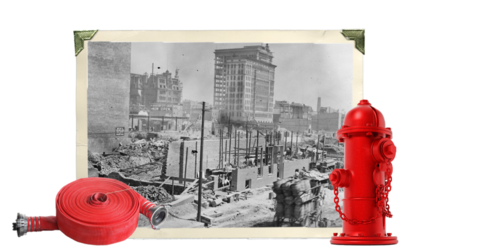When we talk about standards in our personal lives, we might think about the quality we expect in things such as restaurants and first dates. But the standards that exist in science and technology have an even greater impact on our lives. Technical standards keep us safe, enable technology to advance, and help businesses succeed. They quietly make the modern world tick and prevent technological problems that you might not realize could even happen.
The National Institute of Standards and Technology (NIST) has been deeply devoted to efforts in this area for more than 120 years. NIST has brought about improvements to everyday life you may take for granted, and solved problems that have advanced everything from manufacturing to public safety.
Take fire hydrants. If you ever have to call 911 to report a fire, you don’t have to worry about the hoses that firefighters bring when they arrive.
But that wasn’t the case in the Great Baltimore Fire of 1904, which burned for more than a day and destroyed 1,500 buildings. Starting on a quiet Sunday morning, the fire spread quickly and overwhelmed the city’s ability to fight it alone. Fire companies from New York, Philadelphia, Wilmington, Harrisburg and elsewhere swiftly rushed in to help. They had more than enough water and people to fight the fire, but there was a problem: Most of their fire hoses wouldn’t fit the hydrants, prolonging the fire to 30 hours and damaging an area the size of 70 blocks in the city’s business district.

A NIST study found more than 600 variations in firehose fittings across the U.S. NIST worked with the National Fire Protection Association to usher in a national standard for fire hydrant connections. Thanks to this standard, firefighters from different companies could work together more easily to extinguish large fires and prevent another disaster like the 1904 Baltimore blaze.
NIST also looks toward the future in order to avert technological catastrophes. As a prime example, all personal and financial information on the internet faces a grave threat of being exposed by future versions of so-called quantum computers. Such powerful computers could break the current encryption schemes that are used to protect everything from online banking to our email accounts. Thankfully, however, decades of basic research by mathematicians have led to forms of encryption that even quantum computers would have trouble breaking. Using these “quantum-resistant” mathematical functions, NIST has been working with the academic and industrial communities to develop a “post-quantum cryptography” standard, with the initial release in 2022.
Standards are everywhere if you look for them. NIST helped to specify the standard color of school buses to help drivers recognize them instantly. Medical procedures deliver accurate amounts of X-rays and other radiation thanks in part to NIST’s national standards for ionizing radiation and radioactivity. We can use credit cards seamlessly in most places around the world thanks to standards.
Learn more about NIST's history and present activities in standards.














